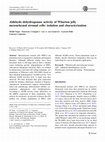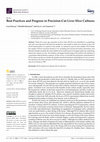Papers by Leo van Grunsven

Cell stem cell, Jan 5, 2018
The development of complex in vitro hepatic systems and artificial liver devices has been hampere... more The development of complex in vitro hepatic systems and artificial liver devices has been hampered by the lack of reliable sources for relevant cell types, such as hepatic stellate cells (HSCs). Here we report efficient differentiation of human pluripotent stem cells into HSC-like cells (iPSC-HSCs). iPSC-HSCs closely resemble primary human HSCs at the transcriptional, cellular, and functional levels and possess a gene expression profile intermediate between that of quiescent and activated HSCs. Functional analyses revealed that iPSC-HSCs accumulate retinyl esters in lipid droplets and are activated in response to mediators of wound healing, similar to their in vivo counterparts. When maintained as 3D spheroids with HepaRG hepatocytes, iPSC-HSCs exhibit a quiescent phenotype but mount a fibrogenic response and secrete pro-collagen in response to known stimuli and hepatocyte toxicity. Thus, this protocol provides a robust in vitro system for studying HSC development, modeling liver fi...

Frontiers in Medicine
In vitro models of human liver disease often fail to mimic the complex 3D structures and cellular... more In vitro models of human liver disease often fail to mimic the complex 3D structures and cellular organizations found in vivo. Precision cut liver slices (PCLS) retain the complex physiological architecture of the native liver and therefore could be an exceptional in vitro liver model. However, the production of PCLS induces a spontaneous culture-induced fibrogenic reaction, limiting the application of PCLS to anti-fibrotic compounds. Our aim was to improve PCLS cultures to allow compound-induced fibrosis induction. Hepatotoxicity in PCLS cultures was analyzed by lactate dehydrogenase leakage and albumin secretion, while fibrogenesis was analyzed by qRT-PCR and western blot for hepatic stellate cell (HSC) activation markers and collagen 6 secretion by enzyme-linked immunosorbent assays (ELISA). We demonstrate that supplementation of 3 mm mouse PCLS cultures with valproate strongly reduces fibrosis and improves cell viability in our PCLS cultures for up to 5 days. Fibrogenesis can st...

Cell Metabolism, 2021
Sepsis is a potentially lethal syndrome resulting from a maladaptive response to infection. Upon ... more Sepsis is a potentially lethal syndrome resulting from a maladaptive response to infection. Upon infection, glucocorticoids are produced as a part of the compensatory response to tolerate sepsis. This tolerance is, however, mitigated in sepsis due to a quickly induced glucocorticoid resistance at the level of the glucocorticoid receptor. Here, we show that defects in the glucocorticoid receptor signaling pathway aggravate sepsis pathophysiology by lowering lactate clearance and sensitizing mice to lactate-induced toxicity. The latter is exerted via an uncontrolled production of vascular endothelial growth factor, resulting in vascular leakage and collapse with severe hypotension, organ damage, and death, all being typical features of a lethal form of sepsis. In conclusion, sepsis leads to glucocorticoid receptor failure and hyperlactatemia, which collectively leads to a lethal vascular collapse.

Chronic liver injury, as observed in non-alcoholic steatohepatitis (NASH), progressive fibrosis, ... more Chronic liver injury, as observed in non-alcoholic steatohepatitis (NASH), progressive fibrosis, and cirrhosis, remains poorly treatable. Steatohepatitis causes hepatocyte loss in part by a direct lipotoxic insult, which is amplified by derangements in the non-parenchymal cellular (NPC) interactive network wherein hepatocytes reside, including, hepatic stellate cells, liver sinusoidal endothelial cells and liver macrophages. To create an in vitro culture model encompassing all these cells that allows studying liver steatosis, inflammation and fibrosis caused by NASH, we here developed a fully defined hydrogel microenvironment, termed hepatocyte maturation (HepMat) gel, that supports maturation and maintenance of pluripotent stem cell (PSC)-derived hepatocyte- and NPC-like cells for at least one month. The HepMat-based co-culture system modeled key molecular and functional features of TGFβ-induced liver fibrosis and fatty-acid induced inflammation and fibrosis better than monoculture...
Science, 2019
Mixed signals at tumor margins The Hippo signaling pathway has been implicated in tumor growth, s... more Mixed signals at tumor margins The Hippo signaling pathway has been implicated in tumor growth, sparking interest in the pathway as a potential therapeutic target. In a study of liver cancer in genetically manipulated mice, Moya et al. discovered that the role of this pathway in tumorigenesis is more complex than previously appreciated. They confirmed that activation of the Hippo pathway within tumor cells drives tumor growth; however, they also found that activation of the pathway in adjacent healthy cells has the opposite effect, suppressing tumor growth. Whether tumor cells survive or are eliminated thus appears to depend on competing signals produced by the tumor and surrounding tissue. Science , this issue p. 1029

Cells, 2019
Inducible cyclization recombinase (Cre) transgenic mouse strains are powerful tools for cell line... more Inducible cyclization recombinase (Cre) transgenic mouse strains are powerful tools for cell lineage tracing and tissue-specific knockout experiments. However, low efficiency or leaky expression can be important pitfalls. Here, we compared the efficiency and specificity of two commonly used cholangiocyte-specific Cre drivers, the Opn-iCreERT2 and Ck19-CreERT drivers, using a tdTomato reporter strain. We found that Opn-iCreERT2 triggered recombination of the tdTomato reporter in 99.9% of all cholangiocytes while Ck19-CreERT only had 32% recombination efficiency after tamoxifen injection. In the absence of tamoxifen, recombination was also induced in 2% of cholangiocytes for the Opn-iCreERT2 driver and in 13% for the Ck19-CreERT driver. For both drivers, Cre recombination was highly specific for cholangiocytes since recombination was rare in other liver cell types. Toxic liver injury ectopically activated Opn-iCreERT2 but not Ck19-CreERT expression in hepatocytes. However, ectopic rec...

Cytotechnology, 2019
Mesenchymal stromal cells (MSCs) are promising tools in regenerative medicine and targeted therap... more Mesenchymal stromal cells (MSCs) are promising tools in regenerative medicine and targeted therapies. Although different origins have been described, there is still huge need to find a valuable source harboring specific subpopulations of MSCs with precise therapeutic functions. Here, we isolated by fluorescence activated cell sorting technique, two populations of Wharton's jelly (WJ)-MSCs based on their aldehyde dehydrogenase (ALDH) activity. Two different ALDH activities (low vs. high) were thus observed. We then analyzed their gene expression profile for stemness, phenotype, response to hypoxia, angiogenesis, hematopoietic support, immunomodulation and multilineage differentiation abilities (osteogenesis, adipogenesis, and chondrogenesis). According to ALDH activity, many differences in the mRNA expression of these populations were noticed. In conclusion, we provide evidences that WJ harbors two distinct populations of MSCs with different ALDH activity. These populations seem to display specific functional competences that may be interesting for concise therapeutic applications. Keywords Wharton jelly mesenchymal stromal cells Á Aldehyde dehydrogenase activity Á Fluorescence activated cell sorting Á Transcriptome analysis Mehdi Najar and Emerence Crompot have contributed equally to this work.

Biochimica et Biophysica Acta (BBA) - Molecular Basis of Disease, 2018
Liver fibrosis is the result of persistent liver injury, and is characterized by sustained scar f... more Liver fibrosis is the result of persistent liver injury, and is characterized by sustained scar formation and disruption of the normal liver architecture. The extent of fibrosis is considered as an important prognostic factor for the patient outcome, as an absence of (early) treatment can lead to the development of liver cirrhosis and hepatocellular carcinoma. Till date, the most sensitive and specific way for the diagnosis and staging of liver fibrosis remains liver biopsy, an invasive diagnostic tool, which is associated with high costs and discomfort for the patient. Over time, non-invasive scoring systems have been developed, of which the measurements of serum markers and liver stiffness are validated for use in the clinic. These tools lack however the sensitivity and specificity to detect small changes in the progression or regression of both early and late stages of fibrosis. Novel non-invasive diagnostic markers with the potential to overcome these limitations have been developed, but often lack validation in large patient cohorts. In this review, we will summarize novel trends in non-invasive markers of liver fibrosis development and will discuss their (dis-)advantages for use in the clinic.

Computational toxicology, 2017
We describe and illustrate a workflow for chemical safety assessment that completely avoids anima... more We describe and illustrate a workflow for chemical safety assessment that completely avoids animal testing. The workflow, which was developed within the SEURAT-1 initiative, is designed to be applicable to cosmetic ingredients as well as to other types of chemicals, e.g. active ingredients in plant protection products, biocides or pharmaceuticals. The aim of this work was to develop a workflow to assess chemical safety without relying on any animal testing, but instead constructing a hypothesis based on existing data, in silico modelling, biokinetic considerations and then by targeted non-animal testing. For illustrative purposes, we consider a hypothetical new ingredient x as a new component in a body lotion formulation. The workflow is divided into tiers in which points of departure are established through in vitro testing and in silico prediction, as the basis for estimating a safe external dose in a repeated use scenario. The workflow includes a series of possible exit (decision...

Stem cell research & therapy, Jun 5, 2017
Progressive liver fibrosis leads to cirrhosis and end-stage liver disease. This disease is a cons... more Progressive liver fibrosis leads to cirrhosis and end-stage liver disease. This disease is a consequence of strong interactions between matrix-producing hepatic stellate cells (HSCs) and resident and infiltrating immune cell populations. Accumulated experimental evidence supports the involvement of adult-derived human liver mesenchymal stem/progenitor cells (ADHLSCs) in liver regeneration. The aim of the present study was to evaluate the influence of ADHLSCs on HSCs, both in vitro and in vivo. Activated human HSCs were co-cultured with ADHLSCs or ADHLSC-conditioned culture medium. The characteristics of the activated human HSCs were assessed by microscopy and biochemical assays, whereas proliferation was analyzed using flow cytometry and immunocytochemistry. The secretion profile of activated HSCs was evaluated by ELISA and Luminex. ADHLSCs were transplanted into a juvenile rat model of fibrosis established after co-administration of phenobarbital and CCl4. When co-cultured with ADH...

Hepatology (Baltimore, Md.), Sep 19, 2017
Acute-on-chronic liver injury is characterized by an important inflammatory response frequently a... more Acute-on-chronic liver injury is characterized by an important inflammatory response frequently associated with endotoxemia. In this context, acute phase proteins such as Pentraxin-3 (PTX3) are released, however, little is known about their role in chronic liver disease. The aim of this study was to elucidate the role of PTX3 in liver injury. Role of PTX3 was evaluated in cultured human cells, liver tissue slices and mice with acute-on-chronic liver injury. PTX3 expression was assessed in tissue and serum samples from 54 patients with alcoholic hepatitis (AH). PTX3 expression was up-regulated in animal models of liver injury and strongly induced by lipopolysaccharide (LPS). Liver cell fractionation showed that macrophages and activated hepatic stellate cells (HSC) were the main cell types expressing PTX3 in liver injury. Ex vivo, and in vivo studies showed that PTX3 treatment attenuated LPS-induced liver injury, inflammation and cell recruitment. Mechanistically, PTX3 mediated HSC w...

Hepatology, 2014
Severe liver diseases are characterized by expansion of liver progenitor cells (LPC), which corre... more Severe liver diseases are characterized by expansion of liver progenitor cells (LPC), which correlates with disease severity. However, the origin and role of LPC in liver physiology and in hepatic injury remains a contentious topic. We found that ductular reaction cells in human cirrhotic livers express hepatocyte nuclear factor 1 homeobox B (HNF1β). However, HNF1β expression was not present in newly generated epithelial cell adhesion molecule (EpCAM)positive hepatocytes. In order to investigate the role of HNF1β-expressing cells we used a tamoxifen-inducible Hnf1βCreER/R26R Yfp/LacZ mouse to lineage-trace Hnf1β + biliary duct cells and to assess their contribution to LPC expansion and hepatocyte generation. Lineage tracing demonstrated no contribution of HNF1β + cells to hepatocytes during liver homeostasis in healthy mice or after loss of liver mass. After acute acetaminophen or carbon tetrachloride injury no contribution of HNF1β + cells to hepatocyte was detected. We next assessed the contribution of Hnf1β +-derived cells following two liver injury models with LPC expansion, a
Gastroenterology, 2021
This is a PDF file of an article that has undergone enhancements after acceptance, such as the ad... more This is a PDF file of an article that has undergone enhancements after acceptance, such as the addition of a cover page and metadata, and formatting for readability, but it is not yet the definitive version of record. This version will undergo additional copyediting, typesetting and review before it is published in its final form, but we are providing this version to give early visibility of the article. Please note that, during the production process, errors may be discovered which could affect the content, and all legal disclaimers that apply to the journal pertain.

International Journal of Molecular Sciences, 2021
Thirty-five years ago, precision-cut liver slices (PCLS) were described as a promising tool and w... more Thirty-five years ago, precision-cut liver slices (PCLS) were described as a promising tool and were expected to become the standard in vitro model to study liver disease as they tick off all characteristics of a good in vitro model. In contrast to most in vitro models, PCLS retain the complex 3D liver structures found in vivo, including cell–cell and cell–matrix interactions, and therefore should constitute the most reliable tool to model and to investigate pathways underlying chronic liver disease in vitro. Nevertheless, the biggest disadvantage of the model is the initiation of a procedure-induced fibrotic response. In this review, we describe the parameters and potential of PCLS cultures and discuss whether the initially described limitations and pitfalls have been overcome. We summarize the latest advances in PCLS research and critically evaluate PCLS use and progress since its invention in 1985.

Cell Death & Disease, 2021
Activated hepatic stellate cells (aHSC) are the main source of extra cellular matrix in liver fib... more Activated hepatic stellate cells (aHSC) are the main source of extra cellular matrix in liver fibrosis. Activation is classically divided in two phases: initiation and perpetuation. Currently, HSC-based therapeutic candidates largely focus on targeting the aHSCs in the perpetuation phase. However, the importance of HSC initiation during chronic liver disease (CLD) remains unclear. Here, we identified transcriptional programs of initiating and activated HSCs by RNA sequencing, using in vitro and in vivo mouse models of fibrosis. Importantly, we show that both programs are active in HSCs during murine and human CLD. In human cirrhotic livers, scar associated mesenchymal cells employ both transcriptional programs at the single cell level. Our results indicate that the transcriptional programs that drive the initiation of HSCs are still active in humans suffering from CLD. We conclude that molecules involved in the initiation of HSC activation, or in the maintenance of aHSCs can be cons...

Frontiers in Medicine, 2021
Liver sinusoidal endothelial cells have a gatekeeper function in liver homeostasis by permitting ... more Liver sinusoidal endothelial cells have a gatekeeper function in liver homeostasis by permitting substrates from the bloodstream into the space of Disse and regulating hepatic stellate cell activation status. Maintenance of LSEC's highly specialized phenotype is crucial for liver homeostasis. During liver fibrosis and cirrhosis, LSEC phenotype and functions are lost by processes known as capillarization and LSEC dysfunction. LSEC capillarization can be demonstrated by the loss of fenestrae (cytoplasmic pores) and the manifestation of a basement membrane. Currently, no protein or genetic markers can clearly distinguish healthy from damaged LSECs in acute or chronic liver disease. Single cell (sc)RNA sequencing efforts have identified several LSEC populations in mouse models for liver disease and in human cirrhotic livers. Still, there are no clearly defined genesets that can identify LSECs or dysfunctional LSEC populations in transcriptome data. Here, we developed genesets that a...
Frontiers in Pharmacology, 2018
P311 was first identified by the group of Studler et al. (1993) in the developing brain. In healt... more P311 was first identified by the group of Studler et al. (1993) in the developing brain. In healthy, but mainly in pathological tissues, P311 is implicated in cell migration and proliferation. Furthermore, evidence in models of tissue fibrosis points to the colocalization with and the stimulation of transforming growth factor β1 by P311. This review provides a comprehensive overview on P311 and discusses its potential as an anti-fibrotic target.

Biomedicine & pharmacotherapy = Biomedecine & pharmacotherapie, 2018
Human hepatic stellate cells (HSCs) demonstrated great immunological plasticity with important co... more Human hepatic stellate cells (HSCs) demonstrated great immunological plasticity with important consequences for liver cell therapy. Activated HSCs (aHSCs) are in vitro reverted (rHSCs) to a quiescent-like phenotype with potential benefit to reduce liver fibrosis. The goal of this study is to establish and compare the immunological profile of activated and in vitro reverted HSCs and to investigate the impact of inflammatory priming on the immunobiology of both HSCs populations. The distribution of inflammatory primed activated and reverted HSCs across the different phases of the cell cycle is assessed by flow cytometry. In addition, Flow analysis was done to assess the expression level of neuronal, endothelial and stromal markers, cell adhesion molecules, human leucocyte antigens, co-stimulatory molecules, immunoregulatory molecules and natural killer ligands. Our results showed that the cell cycle distribution of both HSCs populations is significantly modulated by inflammation. Acco...

Cell death & disease, Jan 2, 2017
Hepatic progenitor cells (HPCs) are small cells with a relative large oval nucleus and a scanty c... more Hepatic progenitor cells (HPCs) are small cells with a relative large oval nucleus and a scanty cytoplasm situated in the canals of Hering that express markers of (immature) hepatocytes and cholangiocytes. HPCs are present in large numbers in alcoholic steatohepatitis (ASH), one of the leading causes of chronic liver disease. To date, the mechanisms responsible for proliferation and differentiation of human HPCs are still poorly understood and the role of HPCs in ASH development is unknown. In this study, we aimed to characterise human HPCs and their interactions with other cells through comparison, on both protein and RNA level, of HPC-enriched cell populations from adult human liver tissue using different isolation methods. Fresh human liver tissue was collected from ASH explant livers and HPC-enriched cell populations were obtained via four different isolation methods: side population (SP), epithelial cell adhesion molecule (EpCAM) and trophoblast antigen 2 (TROP-2) membrane mark...









Uploads
Papers by Leo van Grunsven